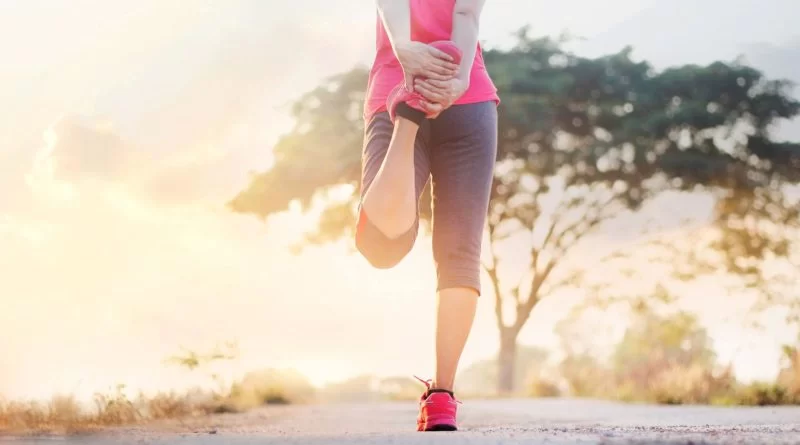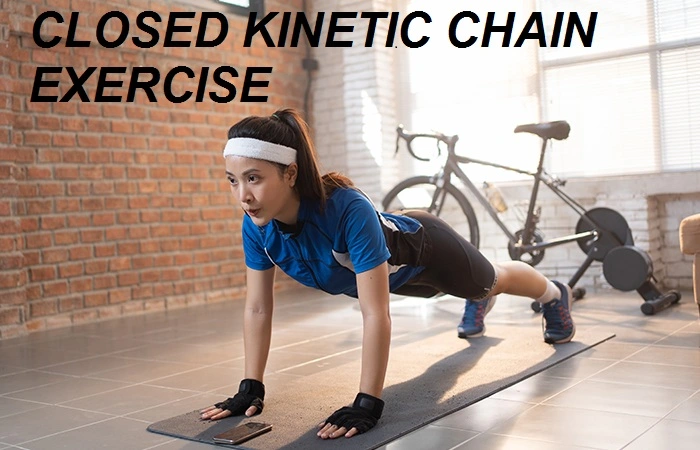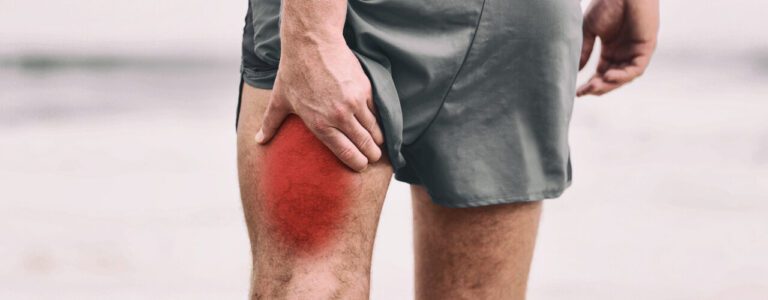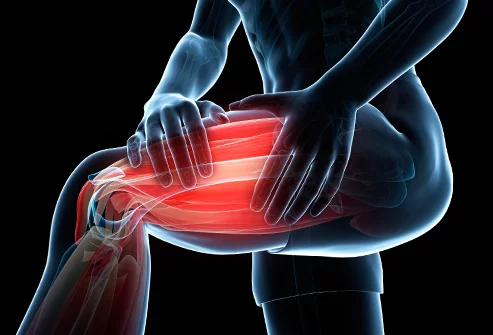Top 10 Best Exercises for Weight loss (obesity)
Here We Update the Top 10 Best exercises for weight loss (obesity), That Are Burns High in Calories and Useful At Home, Easy, And Convenient To Do At Your Own Time.
Table of Contents
1 Squatting exercise:
Top 10 Squat Exercises:
- Squat with an Exercise Ball:
Squats are a great exercise for the glutes, hips and thighs and adding a ball to the move can add great support for the back while allowing you to get into the perfect squat position to protect the knees.
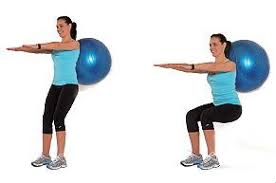
Stand with about hip or shoulder-width apart and place an exercise ball behind your lower back and against a sturdy wall for support.
If you choose to hold weights, you can keep them at your sides, hold them just over the shoulders or prop them on the upper thighs.
Bend the knees and lower into a squat, keeping the knees in line with the toes.
Lower down as far as you can (but no lower than 90 degrees) and push into the heels to go back to starting position.
Do 1-3 sets of 10-16 reps.
Tips :
- Keep your knees in line with your toes
- Press through the heel of your foot as you push up from the squat
- Avoid letting the knee bend over the toe
2 . Ball Squat with Medicine Ball:
Another variation on the squat is to squeeze a medicine ball between the knees. This targets more inner thigh at the same time you’re firing the muscles of the quads, glutes and hamstrings for added intensity.

Place an exercise ball behind your lower back and against a sturdy wall for support.
Squeeze a medium-weight medicine ball between the knees. If you choose to hold weights, you can keep them at your sides, hold them just over the shoulders or prop them on the upper thighs.
Bend the knees and lower into a squat while squeezing the medicine ball to keep it in place.
Lower down as far as you can (but no lower than 90 degrees) and push into the heels to go back to starting position.
Do 1-3 sets of 10-16 reps.
3.Plie Squats:
Plei squats are a great way to target the inner thighs along with the hips and glutes. In this version, you want to keep the knees in line with the toes. Always work with your own flexibility and only go down as low as you comfortably can..
Stand with feet wide, toes out at about a 45-degree angle and place an exercise ball behind your lower back for support.
If you choose to hold weights, you can keep them at your sides or prop them on the hips.
Bend the knees and lower into a squat, keeping the knees in line with the toes.
Lower down as far as your flexibility allows and push into the heels to go back to starting position.
Do 1-3 sets of 10-16 reps.
Tips:
Keep your knees in line with your toes; if your knees want to angle inward, adjust the angle of your toes to a more comfortable place
Press through the heel of your foot as you push up from the lunge to engage your inner thighs
Avoid letting the knee bend over the toe.
4. Bounce squat:
The Bounce Squat is yet another way to work the lower body, this time in a more dynamic way. You’ll use the ball to bounce up and down, pausing at the top of the movement, which will really work the hips and thighs. You’ll find this is a great warm-up move before moving into heavier strength training and it’s also a great way to help exhaust your muscles when you don’t have a lot of time to workout.
Begin by sitting on the ball with your feet about hip-width apart, abs engaged and hands resting on the ball.
Bounce up into a half-squat, keeping your fingers on the ball to make sure it doesn’t roll away.
Sit back down on the ball and immediately bounce up again, pausing at the top before repeating for 1-3 sets of 15-20 reps.
Make sure you keep the ball under you the entire time. You may want to steady the ball against a wall if you feel nervous about this one.
Should You Do Full or Half-Squats?
5. Wall Sits with Leg Lift:
Wall sits are a great exercise for warming up the lower body, building endurance and pre-exhausting the legs before a lower body workout. This can also be an option for people who have trouble with traditional squats and lunges because of knee pain. Because you’re lifting one foot off the floor, you’ll have to work hard to keep your balance. Hold onto a wall or chair for balance if needed.
With a ball against the wall and supporting your back, stand with feet about hip-distance apart.
Lower into a squat until the thighs are parallel to the floor, knees behind the toes.
In the same sitting position, shift your weight to the right foot and lift the left foot off the floor a few inches. Try to keep the weight in the heel of the right foot.
Lower the foot and shift your weight to the left leg, lifting the right foot off the floor. Try to keep the squat position without lifting up.
6Tiptoe Squats:
Another variation of traditional squats is the tiptoe squat, a move that really challenges the quads and calves and requires no equipment. This is a great exercise to do when you want to warm up your legs, especially if you’re traveling or don’t have weights available.

The key to keeping this move safe and effective is to keep the abs engaged throughout the exercise. If you feel any pain in the knees, skip this move.
Stand with feet about hip-distance apart and squat down, placing the hands on the floor, raising up onto the toes.
Stay on the toes as you straighten the knees, taking the hips towards the ceiling.
Keep the abs engaged to protect the lower back.
Still on your toes, bend the knees to lower back down and repeat for 1-3 sets of 8-16 reps.
To modify, place your hands on a chair or other raised platform.
7. Sumo Squat:
The sumo squat is a wide-legged squat with a focus on the inner thighs, a nice variation on traditional squats. Because your toes are turned out at an angle, the key to keeping this move safe is to make sure your knees stay in line with the toes. How far you squat will depend on the flexibility of your inner thighs, so only go as far as you comfortably can.
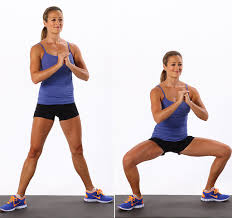
Stand in a wide stance with toes out at about a 45-degree angle (or whatever feels comfortable).
Hold a heavy dumbbell or kettlebell (shown) in both hands and, keeping the torso upright, bend the knees into a squat.
Lower as far as you can, keeping the knees in line with the toes.
Push into the heels to come up and repeat for 1-3 sets of 8-16 reps.
Lower Body and Core Strength Workout
8. Wide Squat Weight Exchange:
The wide squat with a weight exchange is a dynamic version of a plie squat with a little added intensity. The idea is to squat low to place the weight on the floor, stand up, and then squat back down to pick up the weight in the other hand.
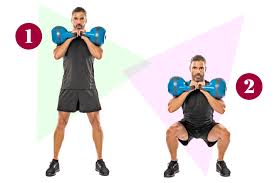
Wide Squat Weight Exchange
Tips:
The key to this exercise is to, first, use a heavy weight to get the most out of the exercise.
Try to get as much squat as possible – In other words, more squat, less reach.
Keep your torso up rather than rounding at the back.
If your inner thighs are tight, you can straddle a step or raised platform to make the move easier.
Stand with the feet wide, toes out at a comfortable angle and hold a very heavy weight in the left hand.
Squat as low as you can, keeping the torso upright and the abs engaged.
Place the weight on the floor and push into the heels to stand up.
Avoid locking the knees at the top of the movement.
Squat once again and pick up the weight with the other hand.
Squat placing the weight down and continue squatting down and up, exchanging the weight each time.
Repeat for 1-3 sets of 10-16 reps. One rep includes both the right and left weight exchange.
How Do I Do the Squat Exercise Safely
9. Goblet Squats:
Goblet squats are an excellent choice for working the lower body, particularly if having a weight on your back, as in barbell squats, is awkward or uncomfortable. Holding the weight in front and close to your body will help you keep your torso upright as you squat down, protecting the back and the knees.
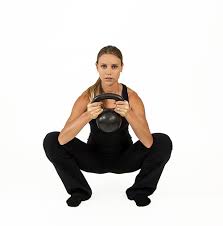
Hold a dumbbell or a kettlebell by the horns (as shown) close to the body, elbows down. Place the feet about hip-width apart, although you should feel free to adjust your foot position if this is uncomfortable or puts a strain on your knees.
Squat down, keeping the weight close to the chest, going as low as you can and bringing the elbows to the inside of the knees.
Keep the torso upright and the abs engaged.
Press back up, squeezing through the glutes. Avoid locking the knees at the top of the movement.
Repeat for 1-3 sets of 8-12 reps.
10. Goblet Squat with Rotation:
Adding an overhead press and rotation to a traditional goblet squat is a great way to increase the intensity of the exercise and raise your heart rate.
Make sure you pivot on both feet as you rotate to one side to avoid tweaking the knees.
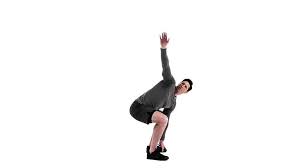
Hold a dumbbell or a kettlebell by the horns (as shown) at chest level, feet wide.
Lower into a squat, bringing the elbows towards the inside of the thighs, or as low as you can.
Make sure you send the hips back and keep the knees from going too far past the toes.
As you stand up, take the weight overhead and rotate to the right, pivoting on both feet.
Lower and repeat on the left, completing 1-3 sets of 8-16 reps, alternating sides.
2. LUNGES:
Lunges can help you develop lower-body strength and endurance, and unlike squats, they are highly effective at
c
evening out muscle imbalances. They’re also a great beginner move.
- Stand tall with feet hip-width apart. Engage core.
- Take a big step forward with right leg and start to shift weight forward so heel hits the floor first.
- Lower body until right thigh is parallel to floor and right shin is vertical (it’s okay if knee shifts forward a little as long as it doesn’t go past right toe). If mobility allows, lightly tap left knee to ground while keeping weight in right heel.
- Press into right heel to drive back up to starting position.
- Repeat on the other side.
Continue alternating leg lifts while staying in your squat as low as you can.
Hold onto a wall or chair for balance if needed and add intensity, if desired, by holding weights.
Repeat for 30-60 seconds, 1-3 times.
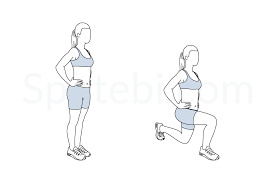
Lunge Variations:
1.Reverse Lunge
Go easy on the knees with this lunge. Stand with feet hip-width apart, engage core, and take a big step backward. Engage glutes as you bend front knee to lower body so back knee lightly taps floor while keeping upper body upright. Drive front heel into floor to return to starting position. Repeat on the other side.
2.Walking Lunge
Perform a forward lunge—and walk it out! At the low point of the lunge, instead of returning to starting position, shift weight forward, drive front heel into floor, and rise up as you bring back foot forward to meet front foot. Reset feet to hip-width apart then repeat on the other side as you continue to move forward.
3. Lateral Lunge
From starting position, take a big step to the right with right foot, keeping toes forward and feet flat on floor. Send hips back to shift weight into right heel as you extend arms in front of you for balance. Push off right heel to return to starting position then repeat on the other side.
4. Curtsy Lunge
With hands on hips and feet wider than hip width, step left leg behind right leg. Bend right knee, engage glutes, and lower body until right thigh is parallel to ground and left knee lightly taps floor. Drive right foot into ground to rise to starting position then repeat on the other side.
5. Clock Lunge
Lunge in all four directions on each side. Lunge forward with right foot, lunge laterally with right foot, reverse lunge on right foot, then curtsy lunge, bringing right foot behind you. Repeat on the other side.
6. Walking Lunge Stretch
Perform a walking lunge by stepping right foot forward. At the bottom of the movement, hover left knee just above floor and twist from the hips to the right over right knee. (Place hands on knee to help deepen the stretch.) Hold for 2 seconds. Press into right heel and bring left foot to meet right to return to standing. Repeat on the other side.
7 . Split Lunge Jump
Stand with feet hip-width apart. Instead of stepping, jump into a forward lunge position with right foot forward. Drive right heel into ground to explosively jump up, switching legs in midair so you land with left leg forward, and immediately lower to a lunge on the other side. Pump arms like you’re running for momentum.
3 Planks:
The plank is one of the best exercises you can do for your core because it builds isometric strength to help sculpt your waistline and improve your posture. And depending on the type of plank you try, you can also engage your back, arms, shoulders, glutes, and hamstrings.
Whether you can hold a plank for 20 seconds or two minutes, you’ll love these fresh variations on the standard move. Bonus: 16 of them don’t require a single piece of equipment.
Forearm plank
This is what most people consider to be a standard plank. Lie facedown with legs extended and elbows bent and directly under shoulders; clasp your hands. Feet should be hip-width apart, and elbows should be shoulder-width apart. Contract your abs, then tuck your toes to lift your body (forearms remain on the ground); you should be in a straight line from head to heels. Hold for 60 seconds or as long as you can
Straight-arm plank
Health-contributing yoga and wellness editor Kristin McGee demonstrates this plank done at the top of push-up position. Kneel on all fours with hands directly under shoulders. Come onto toes, contract abs, and straighten legs; keep body in line from head to heels.
Plank with arm/leg lift
This move from Health contributing fitness editor Tracy Anderson targets your upper back, chest, sides, core, and glutes.
Side Plank
From plank position, press your right hand into a mat and turn your body so your weight is on the outer edge of your right foot; stack your left foot on top. Imagine you have a big beach ball under your right side; press your torso up and away from the ball, extending your left arm with fingers pointed toward the sky. Tighten your lower-ab muscles and brace your entire core. Hold for 60 seconds, then return to plank position and repeat on the left side; that’s 1 rep. Do 3 reps.
Plank jacks
Adding this type of jumping jack to the standard plank engages your abs even more.
Side plank crunch
Try this move from Jillian Michaels and you’ll never call crunches boring again. Lie on left side with left hand on floor beneath left shoulder, right fingers behind head; let inside of right foot rest on floor in front of left foot.
Tighten abs; push into left hand to lift body so it forms a diagonal line from head to heels. Crunch forward and down, bringing right elbow to left elbow; return to starting position. Do 10 reps; switch sides and repeat.

Dolphin plank
This yoga hybrid works your back, abs, and shoulders. Compound exercises that target multiple muscle groups give you a really big bang for your strength-training buck!
Resistance plank
Add a resistance band to work your core, shoulders, AND hamstrings. Place band around wrists and ankles; form a straight-arm plank. Move left hand and right foot out 6 inches. Return to start; repeat on opposite sides. That’s 1 rep. Do 10.
Plank/pelvis tuck
This exercise works both the rectus abdominus (six-pack) and transverse abdominus (waist-cinching corset muscles).
Lie facedown with legs extended, elbows bent, feet hip-width apart, elbows shoulder-width apart. Contract abs, then tuck toes to lift body, elbows directly under shoulders. Hold for 4 breaths. Bend knees (do not touch ground), tilt pelvis up; hold for 4 breaths. Keeping abs tight, straighten legs, hold for 4 breaths. Repeat 3 times.
Push-up side plank
Get in low push-up position with hands under your chest and a little wider than shoulder-width apart (inset). Keeping your body straight and core tight, press up, extending your arms without locking your elbows.
Transfer your weight onto your left hand, lifting your right arm toward the ceiling (shown below). Lower down, and repeat on the opposite side; that’s 1 rep. Do 12 reps.
Caterpillar plank
Standing with feet shoulder-width apart, bend forward at the waist and place your hands on the floor; crawl forward to plank position with shoulders directly over wrists. Bend elbows to lower your body toward the floor, then push back up.

Next, bend your left knee, bring it up and in toward your chest, then rotate your waist as you raise your bent left leg out until it’s parallel to the floor. Return to plank and repeat on the opposite side. Return to standing.
Plank with opposite limb extension
This is a total-body exercise that places extra emphasis on your core. Keep your spine straight and your abs engaged throughout the movement.
One-legged plank
Challenge your balance. From a straight-arm plank, lift right leg up and hold. Lower down. Repeat with left leg.
Side plank with inner thigh raise
Come into side plank on right side with core engaged, hips lifted, sides of both feet on floor, right foot in front of left; lift left arm straight up. Raise right leg as high as you can, then return to floor. Repeat on other side.
Twisting knee plank
Get into a straight-arm plank. Twist your lower body to the left, then to the right; return to center. Bring your left knee forward to touch your left elbow; hold for 1 second, then return to center and repeat on the right side. That’s 1 rep; do 20 reps.
Plank with side snatch
Adding a dumbbell movement works your back, too. Come to plank position with body straight, feet wider than shoulder-width, hands gripping 8- to 10-lb dumbbells.
Engage core muscles; in a single movement (keeping arms straight), twist at the waist (allowing toes to pivot) and lift dumbbell in left hand out to left and up overhead Return to plank position; continue for 60 seconds, then switch sides and repeat.
On-the-ball plank
Place your shins and tops of your feet on a stability ball with your hands on the ground in plank position. Engage your core, squeeze your butt muscles, and hold for 1 minute.
Plank with elbow lift
Get into push-up position with feet shoulder-width apart and hands under shoulders. With abs engaged, squeeze upper back muscles while drawing left elbow back and up (arm close to body, as shown). Slowly straighten arm back down to floor. Repeat with right arm.
Side plank with twist
Health-contributing yoga and wellness editor Kristin McGee demonstrates this Pilates move. Lie on your right side with forearm directly under shoulder, hand perpendicular to your body, and legs stacked. Engage your abs and the right side of your waist, lifting your hips so your body forms a straight line from head to feet. Extend your left arm toward the sky, staying engaged through your core (shown).
Now scoop your left arm in front of your body and reach under the space between your chest and the ground, twisting only from the waist up. Come back up; repeat 4 times, then lower body to the ground. Repeat on the opposite side.
Stir-the-pot-plank
Kneel in front of a stability ball with your forearms and elbows on the ball, hands clasped. Roll ball forward until your legs are extended and your body is in plank position, toes tucked. Your shoulders should be stacked directly above your elbows, chest lifted off the ball, and neck in line with your spine. Brace your abs and make small circles to the right with your forearms, as if stirring a pot. Do 15 reps, then repeat, making circles to the left.
4. Pushups:
Push-ups, like squats, are compound movements using almost all the muscles of your body. You’ll work your chest, shoulders, triceps, back, and abs all while increasing your upper body strength.
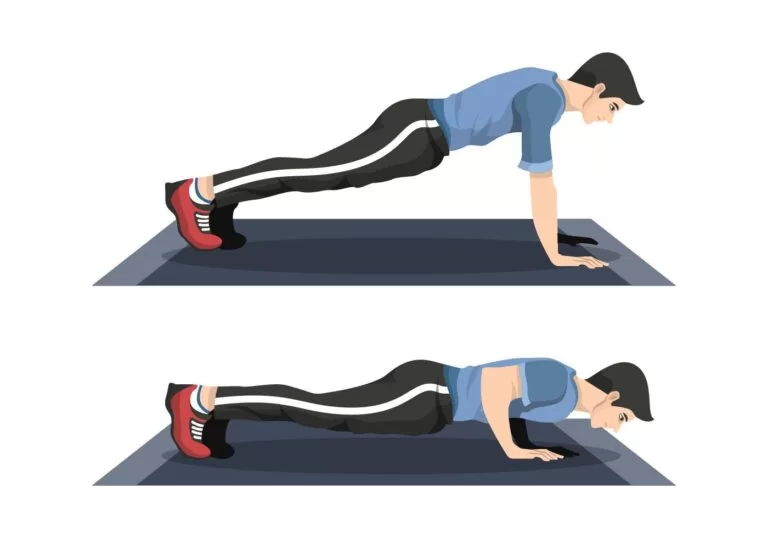
How To: Get into a plank position—hands wider than shoulders and balancing on the toes or, for a modification, on the knees. Your body should be in a straight line from head to knees/heels. Slowly bend your arms and lower your body to the floor, keeping your neck straight and going all the way down until your nose touches the floor, if you can. And then push back up. Try to avoid locking the elbows at the top of the movements.
Pushup Variations:
Pushups on the ball
Pushups with hands on the ball
Incline pushups
Staggered pushups
Pushups with med ball rolls
Divebomber pushups
Pushups with side plank
Resisted pushups
Seesaw pushups on the ball
One-arm triceps pushup
5. Burpees:
How to do it:
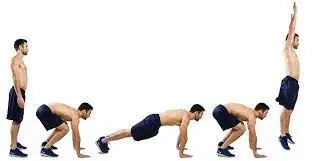
Stand with your feet hip-width apart, core and glutes engaged.
Bend your knees and reach forward to place your hands on the floor, shoulder-width apart.
Kick your legs straight out behind you and immediately lower your entire body down to the ground, bending at the elbows, so that your chest touches the floor.
Use your arms to quickly push your body back up while hopping your legs back under your body.
Explode up, jumping vertically with arms stretched overhead. Land lightly on the balls of your feet with your knees slightly bent, and immediately repeat.
6. Bridging :
How to do it:
Lie on your back with your hands at your sides, knees bent, and feet flat on floor hip-width apart. Loop a medium-strength resistance band around your thighs, just above your knees.
Squeeze your glutes and abs and push through your heels to lift your hips a few inches off the floor until your body forms a straight line from your shoulders to your knees.
Hold this position. Press your legs out and back 10 times, maintaining tension in the band as you pulse in and out.
Slowly lower your hips to return to the starting position.
To mix it up, try adding a few full bridges (lifting the hips up and then lowering them back down) in between each set of pulses, Stokes recommends.
7. Donkey kick:
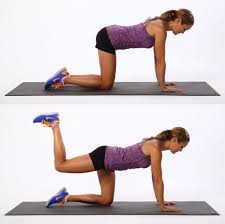
Start on all fours with your knees under your hips and hands under your shoulders.
Flex your right foot and lift it off the floor as you kick it back behind you and straighten your leg completely.
Think about using your glutes to lift your leg. If you start to feel any tension in your lower back, don’t lift your leg as high.
Do all your reps on one side, and then repeat with the other leg.
Other variations include: keeping the knee bent and lifting your foot up toward the ceiling, holding a dumbbell in the crease of the knee of your moving leg, lifting the knee to hip height and pulsing an inch up and down (instead of bringing it all the way back to the floor each time), and holding a small exercise ball in the crease of the knee of your moving leg for extra hamstring activation.
8. Jumping Rope:
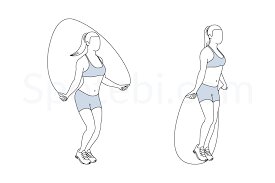
Stand tall, with your back straight and core engaged. Hold one handle in each hand.
Keep your elbows at waist height as you swing the rope forward.
Jump as you hear the rope strike the ground in front of you.
Move at a speed that works for you—the faster you go, the more your heart rate will rise.
Continue jumping for one minute.
9. Mountain Climber:

Start in high plank, with your palms flat on the floor, hands shoulder-width apart (or wider if that’s how you usually do push-ups), shoulders stacked above your wrists, legs extended, and core engaged.
Engage your core and draw your right knee to your chest.
Return to starting position and immediately draw your left knee to your chest.
Continue to alternate, moving quickly.
Make sure to keep your core engaged and back flat throughout. If you have to slow down to maintain form, that’s fine.
Continue for 15 seconds.
10. Leg Raise:
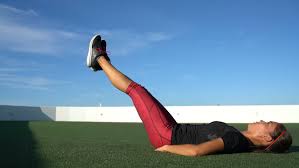
This exercise hits the lower abdominal area and is also a great exercise to strengthen and lengthen the hip flexors, which play a vital role in core stability and strength. Its going to help with your hip mobility which will help with all different areas of your fitness journey, not just strengthening your abs. It’s very common for people to have tight hip flexors, especially if you are sat at a desk all day, so adding these in will help your flexibility in that area. Those lower abs are a difficult area to target, but leg lifts are a great exercise for it. A strong core helps balance and posture so add them in to your routine.
How to do it:
Lie face up with your legs extended and hands at your sides or tucked underneath your hips for extra support.
Slowly raise your legs, keeping them together and as straight as possible, until the soles of your shoes are facing the ceiling.
Then, slowly lower your legs back down. Don’t let your feet touch the floor; instead, keep them hovering a few inches off. That’s 1 rep.
As you do this move, make sure to keep your lower back flat on the floor. If you’re having a tough time doing that, don’t lower your legs as far.

